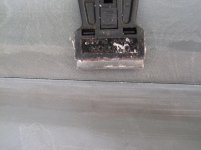i'm convinced that waxing the slate seams is positively evil especially given the fact that we now have this new-fangled plastic filler conventionally called "bondo" which is superior in every way to antiquated wax.... i'm in the process of scraping away as much as possible then i'm going to have to use a solvent to remove the remaining wax. question:
i have enamel reducer, lacquer thinner, mineral spirts et but i really don't want to fill my home with toxic fumes. what is the safest solvent that i can use to rid myself of this evil waxy mess so that the bondo will stick?
i have enamel reducer, lacquer thinner, mineral spirts et but i really don't want to fill my home with toxic fumes. what is the safest solvent that i can use to rid myself of this evil waxy mess so that the bondo will stick?
